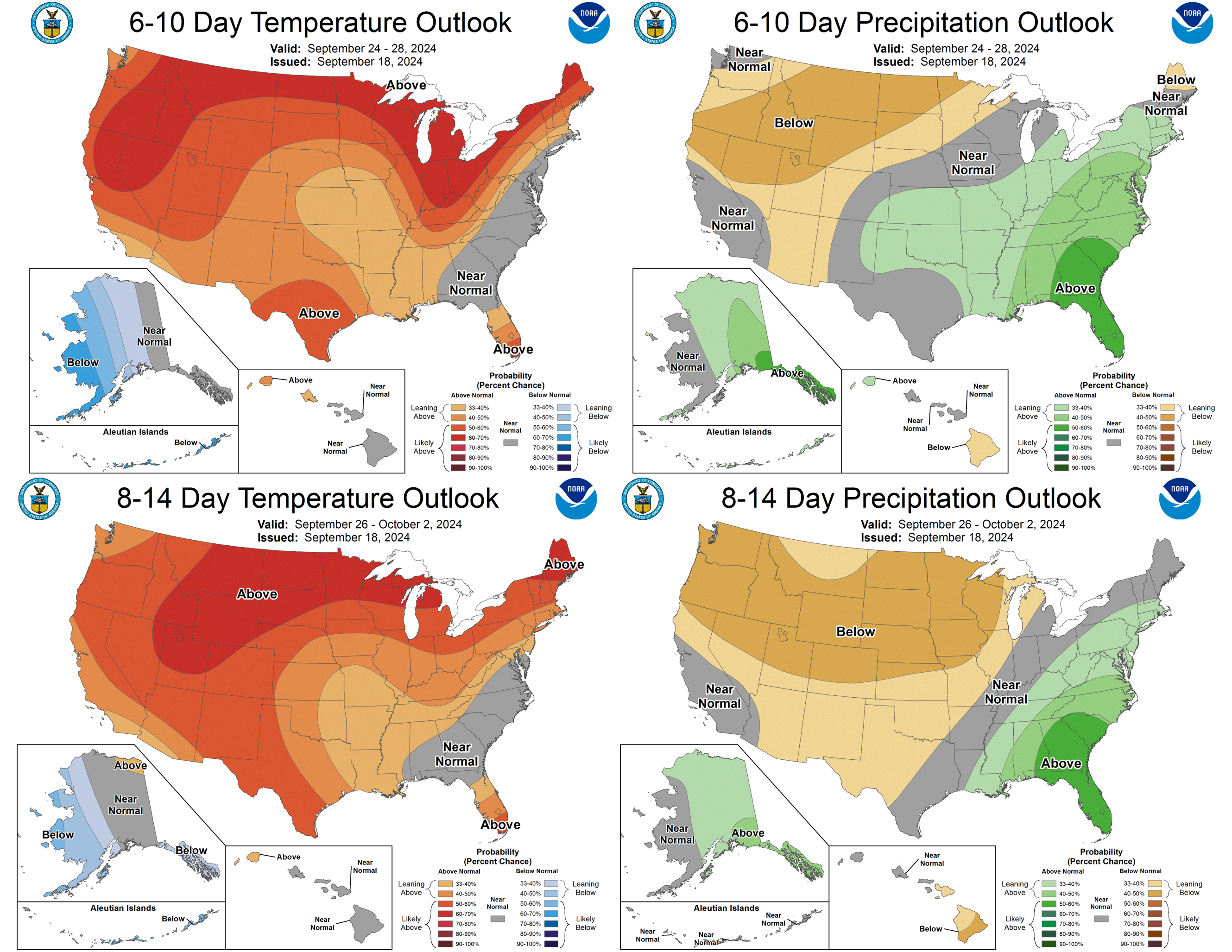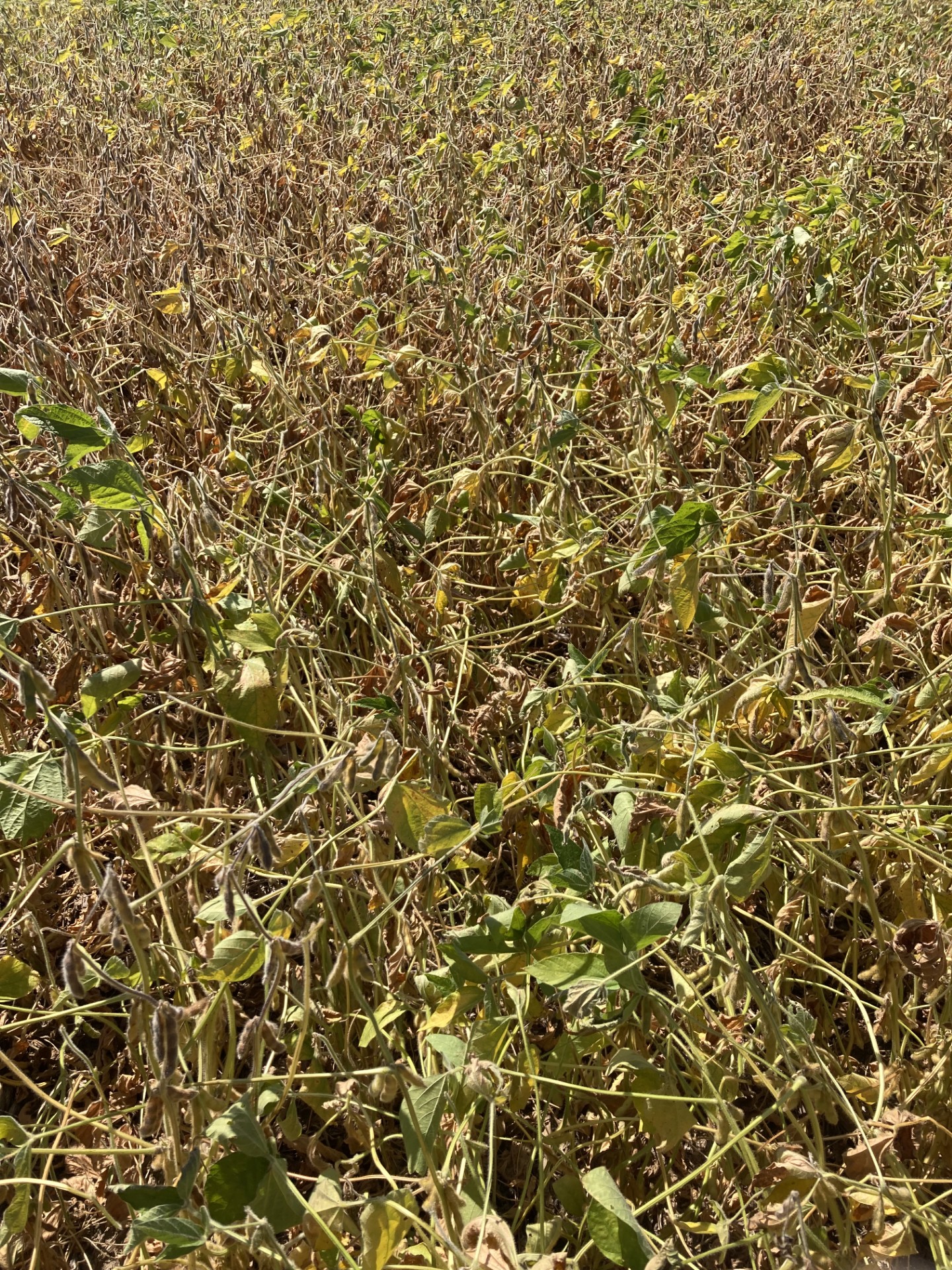Southwest Michigan field crops update – September 19, 2024
Soybean harvest started, and seed corn, potato, and hay harvests continued. Winter wheat and cover crop planting continued.

Weather
Another warm and dry week made for quick soybean dry-down and led to earlier harvest than usual. The dry weather was good for getting into fields, but winter wheat and cover crop planting in dryland areas suffered from the lack of moisture. A chance for light precipitation this weekend will bring cooler temperatures with it, dropping southwest Michigan into the mid-70s for several days.


Crops and pests
Soybeans are still between R6 and R8 but with a higher percentage now in R7 and R8. Harvest began in some fields, and the dry weather has been conducive to reducing seed moisture in preparation for harvest. Watch for green stem and lodging as harvest approaches.

Seed corn and silage corn harvests continued. Commercial corn is almost completely in R5 (dent) and approaching R6 (black layer) if it hasn’t reached it yet already.

Winter wheat planting on irrigated acres continued. For dryland acres, planting has been pushed off in many cases until more moisture is received. Planting now and into early October can maximize tillering as long as sufficient water is applied to the plants.

Potatoes continued with harvest. The nights cooled down a little more than the forecast originally predicted, which allowed more harvest operations to occur throughout the week.
Alfalfa and forage baling and some cutting occurred during the past week.
Cover crop planting continued in some seed corn, potato and early harvested acres.
Weekly water use
|
Estimated weekly crop water use for field crops in Michigan (in/week) |
||||
|---|---|---|---|---|
|
Crop |
Growth stage |
Constantine |
Entrican |
Hart |
|
Corn |
Silk, Blister, Dough, Begin dent |
1.22 |
1.14 |
1.17 |
|
Full dent |
1.11 |
1.04 |
1.06 |
|
|
Black layer |
0.73 |
0.69 |
0.70 |
|
|
Full maturity |
0.12 |
0.11 |
0.12 |
|
|
Soybeans
|
R5 and R6 Begin seed/Full seed
|
1.22 |
1.14 |
1.17 |
|
R7 Begin Mature
|
1.11 |
1.04 |
1.06 |
|
|
R8 95% Pods Mature
|
0.22 |
0.21 |
0.21 |
|
|
Mature |
0.11 |
0.10 |
0.11 |
|
Determining when to apply the last irrigation of the season can be challenging. Ending irrigation too early risks reducing yield potential, while continuing when it's no longer needed wastes money, time and resources. Crops will continue to use water until they reach physiological maturity. For instance, in corn, this occurs when the black layer forms, and in soybeans, it's when a normal pod on the main stem turns its mature color. At this stage, water use decreases significantly, and crops become more tolerant of water stress compared to earlier in the season.
To decide when to stop irrigating, it's important to estimate when your crop will reach maturity and assess how much water remains in the soil. One simple way to check soil moisture is by using a soil auger to probe the root zone about 12 inches deep. If the soil forms a loose ball in sandy loam soils, there's moisture present; if it forms a tight ball, it indicates even higher moisture levels that could sustain the crop for several days. For more information, refer to Michigan State University Extension’s timing the last irrigation article. If you have a soil moisture sensor, it's even better. Additionally, using the crop water use table above can help estimate how much water is required at different growth stages.
The table above presents estimated crop water use for various field crops across three locations in Michigan. This data helps irrigation management decisions by showcasing potential crop evapotranspiration, calculated based on reference evapotranspiration and crop coefficients for each crop growth stage. It is crucial to note that crop water use values vary across regions due to differences in weather conditions, growth stages, agronomic practices and soil properties.
When using these values for irrigation scheduling, be mindful that they assume all applied irrigation water will be utilized by the plants without any loss. Also, these values do not account for any precipitation during the calculation week. For more tools and information on irrigation scheduling tools, please refer to: Irrigation Scheduling Tools.
Reference evapotranspiration data was obtained from Enviroweather, which also offers a model for determining potential crop evapotranspiration. To access this tool, visit Enviroweather, click on "Crops," select your crop and use the potential evapotranspiration tool by choosing your nearest weather station, the latest date of interest and other crop information.
Field Crops Virtual Breakfast Series

Fall weed control, presented by MSU Extension weed specialist Christy Sprague, was the topic for the MSU Extension Field Crops Virtual Breakfast this week. Sprague spoke about weed management considerations in the fall that can greatly impact the 2025 crop. Recordings of this and all the Virtual Breakfast meetings are closed-captioned and available at the Field Crops Virtual Breakfast webpage and the MSU Extension Field Crops Team social media platforms: Facebook, Spotify, YouTube, Apple Podcasts and Twitter.



 Print
Print Email
Email




